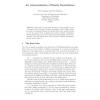Free Online Productivity Tools
i2Speak
i2Symbol
i2OCR
iTex2Img
iWeb2Print
iWeb2Shot
i2Type
iPdf2Split
iPdf2Merge
i2Bopomofo
i2Arabic
i2Style
i2Image
i2PDF
iLatex2Rtf
Sci2ools
112
Voted
JAPLL
2007
2007
An axiomatization of family resemblance
We invoke concepts from the theory of hypergraphs to give a measure of the closeness of family resemblance, and to make precise the idea of a composite likeness. It is shown that for any positive integer m, for any general term possessing any extent of family resemblance strictly greater than m, there is a taxonomical representation of the term whereby each subordinate taxon has an extent of family resemblance strictly greater than m. 1 The Basic Idea The idea of family resemblance was introduced by Wittgenstein[1] as an ingredient of his account of what constitutes possession of a concept, and what is required for the application of a general term. The account is intended to be more satisfactory than corresponding accounts that rely upon the apprehension of essential properties: 66. . . . Consider for example the proceedings we call games. . .if you look at them you will not see something that is common to all, but similarities, relationships, and a whole series of them at that. . . l...
Related Content
| Added | 26 Dec 2010 |
| Updated | 26 Dec 2010 |
| Type | Journal |
| Year | 2007 |
| Where | JAPLL |
| Authors | Ray E. Jennings, Dorian X. Nicholson |
Comments (0)

